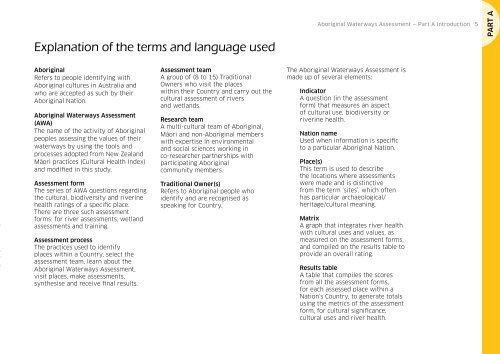Aboriginal Waterways Assessment program
dCckIF
dCckIF
Create successful ePaper yourself
Turn your PDF publications into a flip-book with our unique Google optimized e-Paper software.
Explanation of the terms and language used<br />
<strong>Aboriginal</strong> <strong>Waterways</strong> <strong>Assessment</strong> — Part A Introduction 5<br />
PART A<br />
<strong>Aboriginal</strong><br />
Refers to people identifying with<br />
<strong>Aboriginal</strong> cultures in Australia and<br />
who are accepted as such by their<br />
<strong>Aboriginal</strong> Nation.<br />
<strong>Aboriginal</strong> <strong>Waterways</strong> <strong>Assessment</strong><br />
(AWA)<br />
The name of the activity of <strong>Aboriginal</strong><br />
peoples assessing the values of their<br />
waterways by using the tools and<br />
processes adopted from New Zealand<br />
Māori practices (Cultural Health Index)<br />
and modified in this study.<br />
<strong>Assessment</strong> form<br />
The series of AWA questions regarding<br />
the cultural, biodiversity and riverine<br />
health ratings of a specific place.<br />
There are three such assessment<br />
forms: for river assessments, wetland<br />
assessments and training.<br />
<strong>Assessment</strong> process<br />
The practices used to identify<br />
places within a Country, select the<br />
assessment team, learn about the<br />
<strong>Aboriginal</strong> <strong>Waterways</strong> <strong>Assessment</strong>,<br />
visit places, make assessments,<br />
synthesise and receive final results.<br />
<strong>Assessment</strong> team<br />
A group of (8 to 15) Traditional<br />
Owners who visit the places<br />
within their Country and carry out the<br />
cultural assessment of rivers<br />
and wetlands.<br />
Research team<br />
A multi-cultural team of <strong>Aboriginal</strong>,<br />
Māori and non-<strong>Aboriginal</strong> members<br />
with expertise in environmental<br />
and social sciences working in<br />
co-researcher partnerships with<br />
participating <strong>Aboriginal</strong><br />
community members.<br />
Traditional Owner(s)<br />
Refers to <strong>Aboriginal</strong> people who<br />
identify and are recognised as<br />
speaking for Country.<br />
The <strong>Aboriginal</strong> <strong>Waterways</strong> <strong>Assessment</strong> is<br />
made up of several elements:<br />
Indicator<br />
A question (in the assessment<br />
form) that measures an aspect<br />
of cultural use, biodiversity or<br />
riverine health.<br />
Nation name<br />
Used when information is specific<br />
to a particular <strong>Aboriginal</strong> Nation.<br />
Place(s)<br />
This term is used to describe<br />
the locations where assessments<br />
were made and is distinctive<br />
from the term ‘sites’, which often<br />
has particular archaeological/<br />
heritage/cultural meaning.<br />
Matrix<br />
A graph that integrates river health<br />
with cultural uses and values, as<br />
measured on the assessment forms,<br />
and compiled on the results table to<br />
provide an overall rating.<br />
Results table<br />
A table that compiles the scores<br />
from all the assessment forms,<br />
for each assessed place within a<br />
Nation’s Country, to generate totals<br />
using the metrics of the assessment<br />
form, for cultural significance,<br />
cultural uses and river health.


